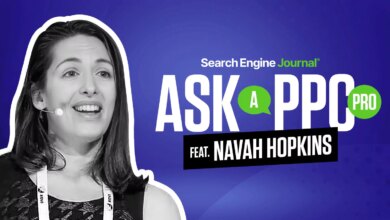The Intersection Of Video SEO And Social Media: Tactics To Win
Video content is now a driving force behind consumers’ attention in today’s digital era.
Gone are the days of simple blog posts and stock images.
Social media has transformed what entices clicks, follows, and likes, displaying a consistent stream of highly engaging visual content for users to sift through.
Visual content, particularly in the form of video, is a winning content format.
In fact, during the third quarter of 2024, a whopping 92% of internet users worldwide watched online videos on a monthly basis. The opportunity is massive, and now is the time for social media marketers to embrace the evolution of effective content marketing.
Videos, however, don’t just show up in social media algorithms and search engine results pages (SERPs) because we create them.
Success is contingent on numerous factors, perhaps the most notable of which is SEO.
Success in today’s digital landscape means knowing how to optimize your videos to appear more favorably in both search and social media. The intersection of video SEO and social media is now more closely tied than ever.
In this post, we will uncover the tried and tested tactics necessary to capture attention, prompt clicks, encourage engagement, and ensure your video shows up when people search for your products or services.
Why Video SEO Matters More Than Ever
More than half (56.4%) of all social media ad budgets in the U.S. went to video in 2024. That share is projected to hit 60% by 2026.
If your strategy doesn’t prioritize video, you’re missing where the money (and the momentum) is going.
Most people are inherently visual learners and, therefore, prefer to consume content in the form of a video rather than reading lengthy chunks of text.
Google, TikTok, Instagram, and YouTube are all strong advocates for this form of content creation.
Google, which acquired YouTube nearly two decades ago, often displays YouTube videos at the top of the SERPs, especially if that video can satisfy search intent quickly.
TikTok has skyrocketed in popularity over recent years, praised for its visually appealing, short-form video format, allowing users to connect with people and businesses in more meaningful ways.
On the other hand, YouTube continues to dominate the social media market, with many younger audiences turning to social media to answer their questions rather than traditional search engines.
YouTube remains the second most popular social network worldwide in terms of monthly active users, right behind Facebook.
Simply put, brands that aren’t creating videos will fall behind as video continues to remain front and center across the web.
From a technical SEO perspective, video content:
- Typically sees viewers sticking around longer and earns attention better than written content.
- Can increase engagement and help surface the video higher in results with optimized thumbnails and metadata.
- Be shared with others or embedded on websites if users deem the video valuable, which helps increase a brand’s domain authority.
- Encourage users to take action by clicking through to a landing page or consuming more video content from the brand.
- Improve brand awareness as watchers find a product or service for the first time.
Bottom line? Video can be a high-impact asset across the funnel if you follow SEO best practices to become more discoverable.
How Social Media Influences Brand Discoverability
Social platforms have become key drivers of content discovery, supported by a recent study that found social media is the preferred product discovery channel for Gen Z and Millennials, with Gen X and Boomers quickly jumping aboard the growing trend.
The same study found 33% respondents reported having discovered a product on social media in the past three months.
Whether it’s TikTok serving as a search engine for Gen Z or Instagram Reels driving top-of-funnel awareness, social media isn’t just a distribution channel. It is now playing an integral role in SEO strategy and helping brands get discovered by highly motivated audiences..
Social engagement and content can both act as indirect ranking signals that can amplify your video’s reach:
- Shares and saves can improve organic search visibility.
- Comments can highlight to search algorithms that consumers find your content engaging and relevant.
- Higher watch times can prompt search engines to see your video as authoritative and credible on the topic.
When your video content performs well socially, it can prompt a ripple effect across the entire digital ecosystem, including coveted positioning in the search results.
Video SEO Strategies That Also Boost Social Performance
Video optimization is crucial to discoverability.
Many foundational SEO tactics remain relevant when it comes to video optimization.
Each platform will require slight refinements. However, overall SEO efforts will look largely similar across each platform.
Here are a few areas that deserve your time and attention.
Conduct Keyword Research
Keyword optimization is still a must to be found in social media and search platforms.
However, the keyword you’d wish to target may vary by platform. Conduct keyword research for each platform you plan to distribute your video to.
To find the keywords that are getting the most traction, type your desired keyword into the search bar to find trending topics and phrases related to that keyword.
For example, TikTok’s Creator Search Insights tool shows what users are searching for most on the platform, along with suggested keywords and even scripts to help you create high-performing promotional content for your business.
Additionally, keyword research tools like TubeBuddy, VidIQ, and Google Trends can help you identify high-volume phrases that resonate with your intended audience.
Don’t stuff your title with keywords and expect it to perform well. Instead, make it compelling and searchable. Example: “Want Clear Skin in 7 Days? This Acne Fix Changed Everything”
Optimize Thumbnails
Your video thumbnail will be the first thing customers might see on both YouTube and social feeds.
It should match the context of the video, but should also be engaging enough to get people to stop scrolling and click on your content instead.
Close-ups tend to perform better as the image appears less abstract than overly crowded images.
Additionally, brand your visuals for consistency so that potential customers start to recognize your video thumbnails whenever they come across them.
Use bold text, expressive faces, and high contrast colors in your video thumbnail to grab attention and communicate the video’s value at a glance.
Leverage Transcripts And Captions
Closed captions aren’t just for making your content more accessible. They can actually help search engines understand your video.
Captions and transcripts provide text-based content for crawlers, which can help boost your video’s search visibility.
YouTube indexes this text, increasing the likelihood of keyword terms and phrases spoken in a video appearing in relevant searches.
Transcripts can be turned into content such as social and blog posts, amplifying your message further.
Implement Structured Data And Schema Markup
If you plan to host videos on your own website, add VideoObject schema markup to help Google better understand your content, such as your video title, description, duration, upload date, and more.
Schema markup can also help improve the chances of your videos appearing in rich results like featured snippets or video carousels, increasing the likelihood of being found in search and customers clicking through to learn more.
Create Custom URLs And Metadata
Your videos should be treated like any other piece of high-value content you produce.
Use a clear and relevant URL structure to improve SEO clarity. Be sure to include keywords in your URLs as well.
In addition to your URLs, you should optimize your video metadata, such as your title tags, descriptions, and thumbnail alt text.
This helps search engines index your videos appropriately and ensures consistency when videos are embedded, shared on social media, or linked across channels.
Craft Engaging Intros
Your introduction is your first opportunity to capture a viewer’s attention. It sets the tone and stage for what’s to come. It makes or breaks if a viewer drops off or if they continue to consume your content.
Keep the first few seconds of your video punchy and unique. You only have a few seconds to make an impression, so make them count. It’s worth getting to the meat of your content quickly.
If you’re using TikTok or Instagram, use trending audio to capture attention and potentially appear to more consumers. Use relevant hashtags to surface keywords and terms related to your video content.
Create Playlists
YouTube gives brands the option to create playlists to help increase engagement and dwell time.
Playlists should include videos that relate to each other to ensure an optimal user experience.
For example, a home improvement company may want to create a playlist featuring “how-to” videos to assist customers who want to tackle home projects on their own.
For YouTube videos, use relevant tags and strong descriptions that include your focus keyword or keywords to boost your SEO efforts. End screens are also an optimal opportunity to give users a next step.
What action do you want the viewer to take next? Include a strong call-to-action (CTA) to encourage viewers to click through to a product page, subscribe to your newsletter, follow your YouTube channel, and more.
Include A Call To Action
For most businesses, a video is not only an opportunity to provide informational content to an audience, but it’s also a tool to encourage viewers to perform a desired action.
A simple end promoter should not be the only place you include your CTA, as some viewers may not watch until the end of your video.
Including your CTA early in your video is recommended to capitalize on viewer attention.
Another area to include your CTA is in your caption (Instagram, Facebook, X, and TikTok) or your description (YouTube).
By putting your CTA in more places, your customers will hear your message loud and clear, and may be more likely to convert.
Common Mistakes To Avoid
Even seasoned marketers can miss the mark with video if they’re not careful.
Keep the following in mind when optimizing your social media for SEO to ensure you adhere to best practices and avoid common mistakes.
Over-Optimizing
Don’t over-optimize your content for search and lose human appeal.
This includes injecting as many keywords as possible within your video, where the dialogue sounds unnatural and unhelpful. Over-optimizing may also look like adding too many irrelevant tags.
Ignoring Platform-Specific Specs
Each social media platform has specific video guidelines to adhere to, such as dimensions, length, and caption formats.
Be sure to familiarize yourself with each to provide a positive user experience irrespective of the platform.
Failing To Engage With Your Audience
If your business has time to create a video, it must also make the time to respond to comments.
Social media responses act as a signal for improved search visibility, helping your content be highlighted.
Responses also encourage interaction and show that your business values its customers.
Not Testing
You might not get it right the first time, which is where A/B testing becomes useful.
A/B testing allows your business to see what’s resonating with users and what isn’t. Test your video titles, thumbnails, copy, and CTAs to see what works best.
Only Focusing On One Platform
Social media users are active on myriad social media platforms. You want your business to be found everywhere your customers are looking.
Don’t focus all your attention on one place. Instead, spread the love and create a solid social media presence across the platforms where your target demographic spends their time.
Not Posting Consistently
Make your presence known on social media. Just as you regularly produce written content, your brand should also produce a steady stream of video content.
Customers prefer diverse content formats. Video increases engagement and also helps break up your feed, helping you to create a more visually appealing profile for your business.
Not Linking To Your Social Media Profiles On GBP
Your Google Business Profile offers myriad opportunities to advertise your business and your products or services to searchers.
One of these features is the ability to add your business’s social media profile links to your GBP.
Take advantage of this free opportunity to help drive customers to your social media channels to learn more about your brand and engage with your community.
Why Alignment Wins
Video SEO and social media go hand-in-hand.
Proper video SEO helps your brand appear more favorably in the SERPs, improves your chances of appearing for featured snippets, and ultimately drives more eyes to your landing pages.
As social media and SEO continue to intertwine, optimizing video for each and every social media channel is a non-negotiable.
To stay ahead, social media marketers should:
- Follow best practices for each platform.
- Prioritize creating and distributing video content.
- Let data guide your video strategy.
- Test different formats and messaging to see what works best.
- Learn where your target audience spends their time.
- Respond to feedback and comments.
- Optimize every single video.
- Delve into the data to uncover key findings.
Marketers who optimize for both discovery and engagement, while also adhering to the unique dynamics of each platform, will be the ones who win attention, build authority, and drive more potential revenue for the business.
Start by creating one video. Choose a high-performing piece of content, turn it into a 60-second video, optimize it for search and social, and track how it performs across platforms.
Chances are, the return will be well worth the work.
More Resources:
Featured Image: Xavier Lorenzo/Shutterstock




